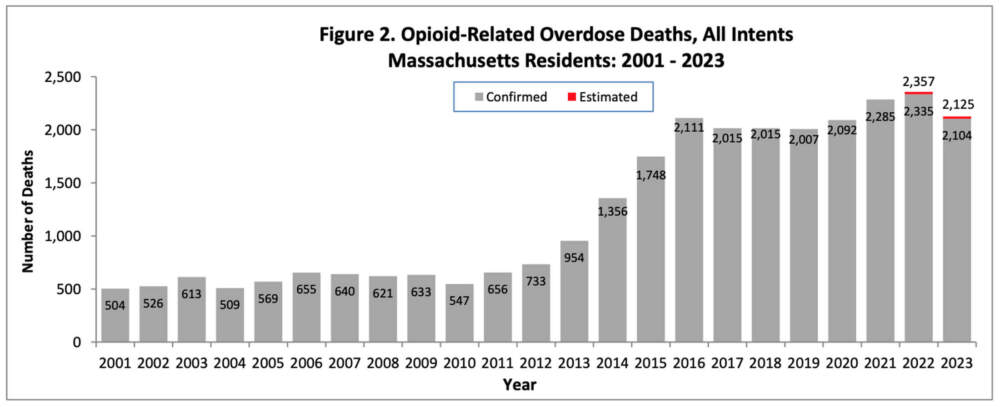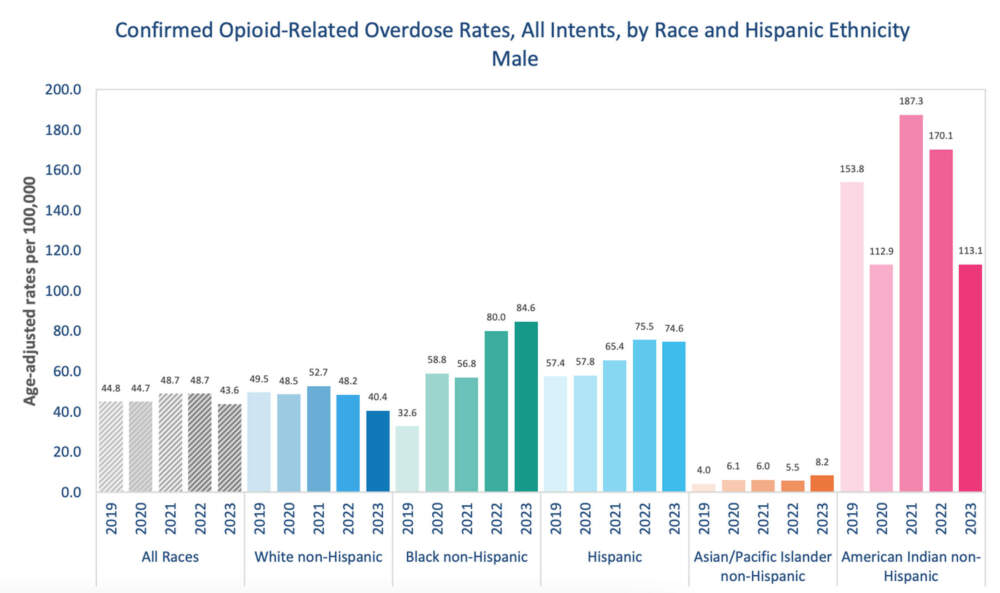Advertisement
Overdose deaths in Mass. dropped 10%, but fatalities rose for Black men
Deaths after a drug overdose dropped 10% last year in Massachusetts as compared to 2022, according to data released Wednesday by the state Department of Public Health. It’s the largest single-year decrease in 13 years.

Some addiction experts who’ve struggled against the numbing impact of the overdose crisis said they cried when they saw the numbers. The report also included preliminary data that suggests the trend continues so far this year.
“These are people’s children and family members, and we need to give them all the respect that they deserve,” said Deirdre Calvert who runs the Bureau of Substance Use Services at the Massachusetts Department of Public Health. “We need to really focus though on the communities that we are missing.”
The drop in fatal overdoses was most significant for white residents who use drugs. Hispanic women saw a larger decrease than Hispanic men. But opioid-related deaths among Black men increased, and they held steady for Black women at the highest rates ever seen in Massachusetts.
“This is yet another example of racism as a serious public health threat,” said state Public Health Commissioner Dr. Robbie Goldstein. “And it reflects the decades of racism inherent to the war on drugs.”

Goldstein said it’s been hard to get resources into some communities with the highest overdose rates, but the state is making progress. State-funded programs to help people of color avoid an overdose after release from prison or jail have served 679 men since 2021.
In addition, 20 community groups are receiving small grants for prevention and drug use intervention. Goldstein added that state efforts to reduce complications during pregnancy and childbirth also play a role because more than 40% of the severe events these programs target are related to substance use.
Some of the millions of dollars the state has received from settlements with opioid makers, marketers and distributors are helping to fund efforts to address inequities in overdose rates, state officials said.
According to the new state data, white men saw the largest decrease in deaths, 16%, last year. Among white women, deaths dipped slightly. Goldstein and Calvert listed a range of efforts that may be contributing to the lower numbers: widespread access to the overdose reversal drug naloxone, a phone line to help people avoid using drugs alone, more mobile treatment clinics and housing that does not require sobriety.
Advertisement
"Frankly, the number of deaths from addiction and death is still unacceptable ..."
Dr. Hugh Taylor
Even with a 10% overall decrease, the state lost 2,125 people to an overdose last year. That’s roughly six people a day, on average. Fentanyl is still the main driver of deaths, health officials said. Three cities saw fatal overdoses increase last year: Boston, Holyoke and Taunton. But six counties marked a rise in deaths: Nantucket, Suffolk, Norfolk, Franklin, Berkshire and Hampden.
Goldstein said the Department of Public Health continues to urge state lawmakers to help communities open overdose prevention centers aimed at reducing deaths even further. A coalition, including the Massachusetts Medical Society, is urging swift passage of a bill to provide liability protection for people who would monitor drug use in these facilities, and their clients. It has not been scheduled for a vote by the House or Senate.
“Frankly, the number of deaths from addiction and death is still unacceptable, so we can not pull back on our efforts to do everything possible to address this epidemic,” said Dr. Hugh Taylor, president of the medical society.
Nationwide, overdose deaths were down about 3% last year. The larger drop in Massachusetts is prompting a lot of discussion about what’s working here. Julie Burns, who leads the nonprofit advocacy group RIZE Massachusetts, said better access to fentanyl test strips has helped save lives, as has funding for drug testing programs that alert people who use drugs and state officials about what’s in the drug supply.
“There are still too many people dying,” Burns said. “But taking a minute to reflect on the fact that there was a 10% decrease is important — and then doubling down on those programs that work.”
Editor's note: This post has been updated to reflect new information about Boston and revised information from the state Department of Public Health about the time period since the last single-year decrease of this size. It is 13 years, according to state health officials.
This article was originally published on June 12, 2024.
